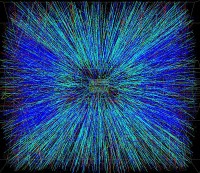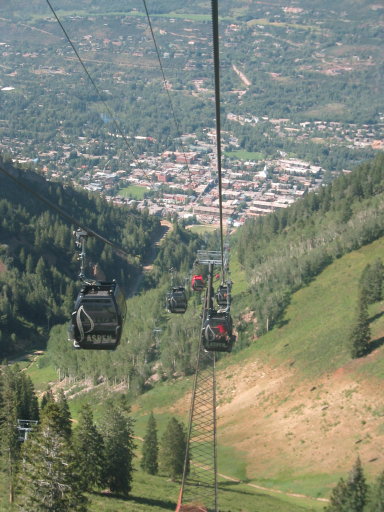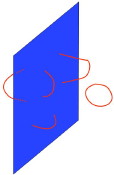Cosmic Ray Guns

From the Chandra X-ray Observatory site (where you can find lovely larger versions of this image):
[…] Click to continue reading this post

From the Chandra X-ray Observatory site (where you can find lovely larger versions of this image):
[…] Click to continue reading this post
Over on Correlations, I talked a bit about the History Channel’s science show “The Universe” (as I have here), and pointed out that the new season (season two) has already begun being broadcast. Here’s hoping that it’s a good series of programmes that will be enjoyable and informative. The show’s website is here.
Well, I’ve learned that the second episode, tomorrow’s (showing at 9:00pm), is one of those that i did some shooting for over the last two months at a number of places around LA. Rather than repeat, here’s what I said:
The next one, to air on Tuesday the 4th December, is called “Cosmic Holes” (yeah, I know), and the subject matter will be right on the edge of the known and the unknown, talking about black holes, white holes, and wormholes. While we know that the first are out there, the second two, while also solutions of Einstein’s General Relativity, are still theoretical constructs (and not without problems). The show explores some of the ideas and the prospects for the ideas surrounding
Just spotted this in the Guardian:
Next Thursday, the British Interplanetary Society is bringing together physicists for a conference entitled Faster than Light: Breaking the Interstellar Distance Barrier. “The main purpose is to raise awareness of this obscure field of research within general relativity and quantum field theory and attract new and particularly young researchers to work on the technical problems,” said organiser Kelvin Long.
Wow! I had no idea there was such a meeting. Did anyone reading go?! What is the British Interplanetary Society? From their site I found this quote: […] Click to continue reading this post
___________________________________________________________________________________
Hot, hot, hot, hot stuff
hot, hot, hot
hot, hot, hot, hot stuff
hot, hot, hot
– from “Hot Stuff”, by Donna Summer (1979). I refer to not only the physics but the c. 100 oF temperatures we’ve been having here every day recently.
___________________________________________________________________________________
On my way back from the conference, I spotted this book (left) last Saturday in Foyles (the booksellers) in London 1.  It is a collection of reprints of a lot of the papers forming the foundations of the physics of the quark-gluon plasma (QGP) idea, going back the early to mid 1970s with such papers as Collins and Perry (Gosh, I had no idea Malcolm was one of the early workers on this idea. He’s much more thought of as associated with black holes, gravity, strings and so forth, ideas which – ironically – have recently turned out to be relevant to the discussions of the physics too. See my recent post, and there are also various popular articles to be found2).
It is a collection of reprints of a lot of the papers forming the foundations of the physics of the quark-gluon plasma (QGP) idea, going back the early to mid 1970s with such papers as Collins and Perry (Gosh, I had no idea Malcolm was one of the early workers on this idea. He’s much more thought of as associated with black holes, gravity, strings and so forth, ideas which – ironically – have recently turned out to be relevant to the discussions of the physics too. See my recent post, and there are also various popular articles to be found2).
Putting aside the usual ridiculous price that Springer Elsevier charges for books, I found myself in two minds about this book, in view of the surprises being uncovered about the properties of this remarkable state of matter at the RHIC experiment. Is this collection of early papers a useful working tool, or is it now just of historical interest, since many of the basic expectations about the properties of the plasma seem now to be incorrect?
 Well, after a bit of thought, I decided that the latter view would be way too hasty. First and foremost, on a general level, even if some of the computations in some papers were done in the “wrong” light (it’s a strongly coupled liquid that flows, not a weakly coupled gas of quarks and gluons), much of their content will still be useful in many ways – good and correct calculations last for all time, it is the sense of the words decorating them that may crumble over time. More specifically, one can worry about whether there were assumptions (and approximations based on those) that went into the computations that will render […] Click to continue reading this post
Well, after a bit of thought, I decided that the latter view would be way too hasty. First and foremost, on a general level, even if some of the computations in some papers were done in the “wrong” light (it’s a strongly coupled liquid that flows, not a weakly coupled gas of quarks and gluons), much of their content will still be useful in many ways – good and correct calculations last for all time, it is the sense of the words decorating them that may crumble over time. More specifically, one can worry about whether there were assumptions (and approximations based on those) that went into the computations that will render […] Click to continue reading this post
So the conference here at the Newton Institute in Cambridge is simply marvellous. I’m so glad I came, and so happy that I was invited to attend and make a contribution to it by giving a talk and having discussions. It’s a rather splendid combination of experimentalists, phenomenologists, and various hardcore theorists of various sorts, and there are ideas just flying around and bouncing off the walls. The title is “Exploring QCD: Deconfinement, Extreme Environments and Holography”, (it’s organized by Nick Evans, Simon Hands, and Mike Teper) and the focus is very much the fascinating nuclear physics of heavy ion collisions at the RHIC experiment at Brookhaven, and the experiments to come on heavy ion collisions at the LHC at CERN. The latter is an aspect of the physics to be done at the LHC that you don’t hear about much because it is sidestepped in favour of discussions about the Higgs, origin of mass, supersymmetry, theories of everything – such as strings, microscopic black holes, extra dimensions and all that other good stuff. (See earlier discussions here, here and here.)
Well, the great thing is that there’s been plenty of discussion of black holes, extra dimensions, strings, and so forth at the conference because of a great deal of promise of its relevance to nuclear physics. It’s been right alongside the discussion of experimental results, and other theoretical approaches such as work on computer simulations of aspects of QCD (“lattice QCD”) and studies involving other techniques. There’s very much a spirit of open-minded exchange among all the various parties […] Click to continue reading this post
Ok, there’s “The Elegant Universe”, and “The Ambidextrous Universe”…. even “Stephen Hawking’s Universe”… and so on for these titles. But how about “The Scary Universe” or “The Dangerous Universe”? (Personally, I wish we’d just stop with the whole “The fill-in-the-blank Universe” stuff, so I probably should have not written this first paragraph.)
Well, I myself don’t think of the Universe that way, but tonight (at 9:00pm) the History Channel will be presenting the next show in their series (called “The Universe”), which is about (they say) the Most Dangerous Place In The Universe”. It looks as though it will be a survey of various places where a lot of very energetic activity is taking place, powering some of the most powerful phenomena we’ve ever seen, such as quasars, magnetars, and so forth. So black holes will feature quite a bit, I imagine, and although I probably should not really be telling you about it before I’ve had a chance to see it (recall my remarks about the windy shooting conditions here), I think (I’m not sure) that I’ll be making an appearance as one of the contributors. (I did not get caught off guard this time.)
The whole “dangerous” motif is a sort of deliberately sensational way of presenting […] Click to continue reading this post
 I stopped the previous post rather abruptly (I had to do another task and then run some errands) without getting to tell you a little twist at the end of the story. Here it is.
I stopped the previous post rather abruptly (I had to do another task and then run some errands) without getting to tell you a little twist at the end of the story. Here it is.
Having chipped away at the thoughts that Strominger’s talk stirred in my head for several days last week, scribbling equations to check that all I was thinking was on the right track (and chatting a couple of times with Nick Halmagyi), I decided that it was all fitting together so nicely that the framework and my extensions of it just had to be true. There was that feeling that it was too nice to be wrong, and it passed all the obvious checks I could think of. There were two independent consistency checks everything had to pass (using my way of formulating things) and they gave exactly the right results as required by the general setup, with no room for maneuver.
When that happens so nicely, usually at that point in thinking about a physics problem, a thought occurs to me. If I’m playing with a good idea and everything is working so well, then there’s at least 200 other people in the field who probably are also playing with it, and 199 of them have way more time than I do to think it through and write it up before I can. One should not really worry about these things in an ideal world, but I’d be lying to you if I said it did not come up as a concern from time to time. I’ve a history of having my thunder stolen out from under me several times in the field (and not always accidentally), so I’m a bit gun shy.
Anyway, I started writing a draft of the paper on Thursday the way I usually do: I write […] Click to continue reading this post
I’ve been spending the day so far as an administrator, and not a researcher, since I have to present the results of two committees’ deliberations at one of the big annual organizational meetings tomorrow here at the Aspen Center for Physics. So I’ve been gathering and arranging data in a presentable form. Enough. I will take a break and blog a tiny bit before turning to a truly riveting task – reviewing an introductory physics textbook for a publisher… (Sigh…it is not so easy to escape these things out of semester time.)
I had big plans to do a hike each day on the weekend, but physics intervened. I should explain a bit more. Earlier last week I eventually got around to following Nick’s suggestion from an earlier post to take a look at Andy Strominger’s Strings 2007 talk entitled “Search for the Holographic Dual of N Heterotic Strings”. It was the usual nice Strominger talk, where he motivates the physics very well, and presents interesting and clear  thoughts on the problem in hand. I shall try to say a bit more about what it is about later on, but the general gist of it is that it is to do with understanding certain types of four dimensional black hole in string theory. As you may know, one of the extraordinarily successful results in string theory in the last decade (and slightly more) has been that we can understand one of the most central results of semi-classical quantum gravity -that they have an entropy and behave like thermodynamical objects (the work of Bekenstein and of Hawking from the early 70s)- in precise terms in the full theory of quantum gravity that string theory appears to present us with. This started with the work of Strominger and Vafa in 1996, that showed how to describe a large class of black holes as essentially made of extended objects called D-branes (about which I’ve spoken at length earlier1).
thoughts on the problem in hand. I shall try to say a bit more about what it is about later on, but the general gist of it is that it is to do with understanding certain types of four dimensional black hole in string theory. As you may know, one of the extraordinarily successful results in string theory in the last decade (and slightly more) has been that we can understand one of the most central results of semi-classical quantum gravity -that they have an entropy and behave like thermodynamical objects (the work of Bekenstein and of Hawking from the early 70s)- in precise terms in the full theory of quantum gravity that string theory appears to present us with. This started with the work of Strominger and Vafa in 1996, that showed how to describe a large class of black holes as essentially made of extended objects called D-branes (about which I’ve spoken at length earlier1).
Just to fill in the gaps roughly: Hawking’s result that black holes can radiate as thermodynamical objects comes from taking Einstein’s theory of General Relativity and combining it with Quantum Mechanics in a partial way. He could not really do much better since there was no proper quantum theory of gravity at the time, but even in […] Click to continue reading this post